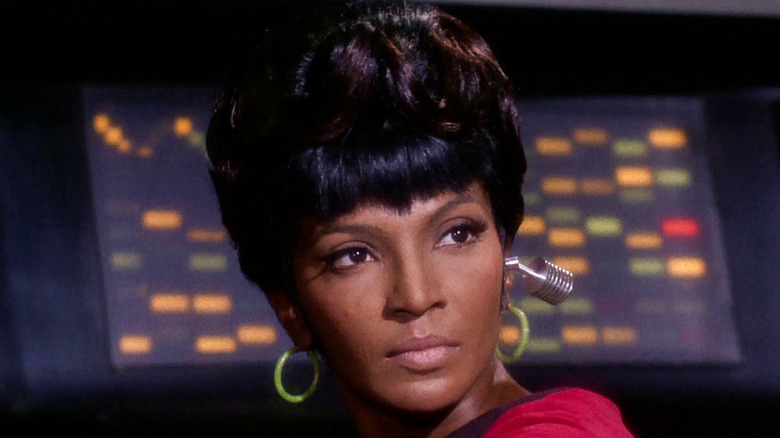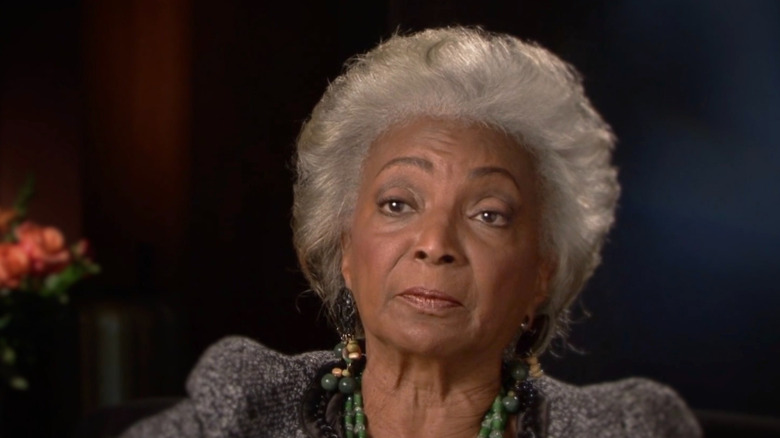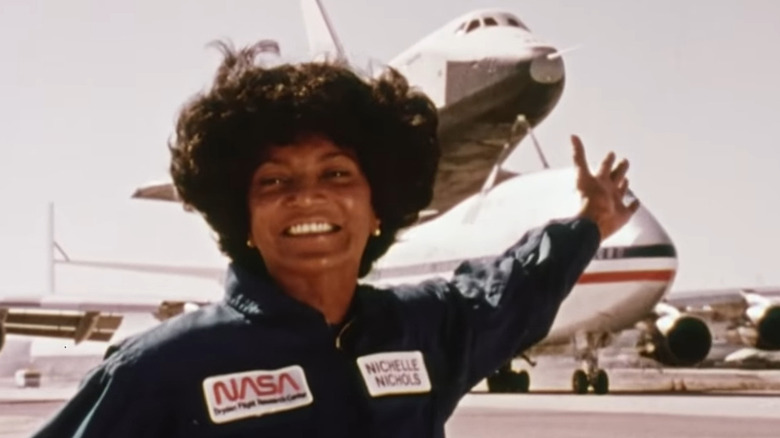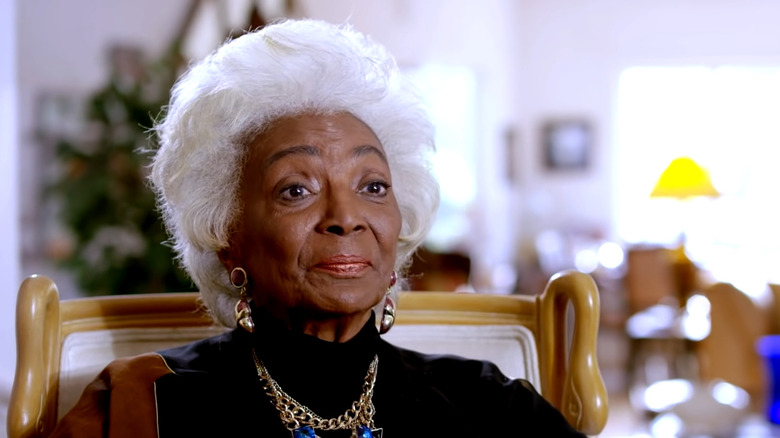After Star Trek Ended, Nichelle Nichols Went To Work For NASA
"Star Trek" has endured for decades as a beacon of hope as we try to strive toward a future where humanity has allowed bigotry and prejudice to become relics of an antiquated past. Gene Roddenbery's sci-fi adventure series presented a world that has embraced the thrilling concept of new discoveries just waiting to be found in the cosmos. With just three seasons, the original run of "Star Trek" became one of the defining shows of the '60s, one of those reasons being the diverse casting aboard one of Starfleet's most famous vessels.
On July 30, 2022, the U.S.S. Enterprise lost its Chief Communications Officer in Nichelle Nichols, who passed away at the age of 89. Her tenure as Uhura left a considerable impression in the hearts and minds of Trekkies, but most importantly, she set a trailblazing example as one of the first major recurring roles given to a Black woman on television. Nichols was also front and center with the small screen's first interracial kiss with co-star William Shatner.
If you really want an idea of how vital her legacy aboard the Enterprise was, it was none other than Dr. Martin Luther King Jr. who convinced Nichols to stay on after she expressed doubts about remaining on the show. It was the endorsement of a lifetime, and she knew it.
It can't be understated how revolutionary it was to see a Black woman in a meaningful role on television. And while "Star Trek" will continue to define her legacy, Nichols' work off-set effectively changed the space program as we know it.
Space. What's in it for me?
It wasn't enough that Nichols pretended to live among the stars — she had the spirit and determination to reach for them too, or at least make them accessible to people who never would have been given the opportunity.
"Woman of Motion" is a wonderful documentary that chronicles Nichols' from her days aboard the Enterprise to the future that she envisioned all those decades ago. Within the film, Nichols speaks about the complications of watching a national event like Apollo 11 landing on the moon. She was in absolute awe of the achievement, but was dispirited by the sea of white men that made it happen. People had looked up to her because she provided the kind of representation that didn't exist on television, and now she was in a place where she wanted to see women and people of color celebrating these victories .
Of course, the notoriety of her time on "Star Trek" allowed Nichols the chance to make her thoughts known on the inequalities happening at NASA through a series of articles highlighting the systemic oversight of the predominately white male participants. In 1977, Nichols was appointed to the Board of Directors for the National Space Institute, which ultimately set the stage for a speech that would set the wheels of change in motion.
As she explains in "Woman in Motion," Nichols addressed over 3,000 members at their annual board council meeting, asking the entire room of white men, "Space, what's in it for me?" She saw impossibilities become possible, and wondered why women and applicants of color were being shut out of the chance to experience these miracles. NASA heard Nichols, and wondered where to go from there.
Nichols forged a new frontier of her own making
In affiliation with her inclusive production company, Women in Motion, Nichols became a recruiter for NASA. There were a slew of discrepancies in their system, and she was going to correct them. According to Nichols in "Woman in Motion," applicants of color didn't apply because they didn't believe NASA was serious in giving them a fair shot." She made it explicitly clear that if her role conjured no new results from within the program, she was going to rip them apart by any means necessary:
"I will bring you so many qualified people, you will have no choice. And if I have done my work and it's still an all-white male Astronaut Corps, I will be your worst nightmare because I will file a class action lawsuit against you. I will go and speak before Congress, and I will expose what I have done."
After going through the astronaut training program herself, Nichols set out to recruit as many applicants as she could throughout every corner of the United States. She was also involved in a bunch of recruitment videos. Even when the Pentagon tried to play the intimidation card, saying she couldn't interfere with any of their recruitment, Nichols hilariously fooled them into confirming a loophole, which allowed her to seek out potential recruits that weren't already on their list. It just made it easier for her to find the kind of people she was looking for, as she could advise them to apply directly to NASA.
Applications went from 1,500 to 8,000, with over 2,649 of them being from the applicants she'd been fighting for.
Legacy of a trailbalzer
It's spectacular how Nichols not only set the path for fellow "Star Trek" alum such as Whoopi Goldberg, LeVar Burton, and Sonequa Martin-Green, but also true space pioneers. Without her, Guion Bluford wouldn't have become the first Black man in space. Frederick Gregory wouldn't have been the first Black man to pilot a space shuttle. Sally Ride and Judy Resnik, who became a close friend of Nichols, wouldn't have set the stage as some of the first women in space.
Nichols' presence at NASA came full circle in 1992 when Dr. Mae Jemison became the first Black woman astronaut ... and also appeared in a brief cameo in an episode of "Star Trek: The Next Generation." Of course, Nichols was there on set to see it all unfold.
Nichols' recruitment tour may have only lasted about four months, but if you look at the legacy she left behind for the future of NASA, it's hard to see anything but a trailblazing effort on her part. Nichols got to play pretend within a much more inclusive vision of the future, and in turn, make her own.
In the event we can pull ourselves of this dark hole we, as a species, are currently trapped in, the potential Starfleet of our world will have an origin that can be directly traced back to a kind-hearted and determined woman who wanted to be the first Black ballerina, and instead, embraced the prospect of a better future. She will be dearly missed. Live long and prosper.
"Woman in Motion" is currently available to stream on Paramount+, Peacock, VUDU and Kanopy.



